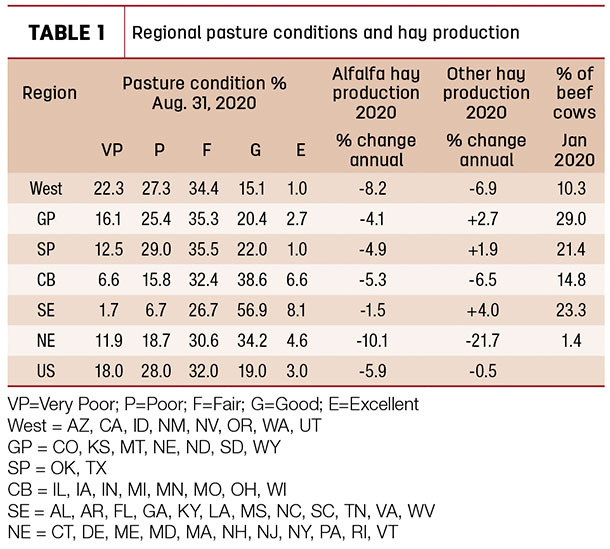One-third of the U.S. is in drought, predominantly in the Western half of the country.
Only about 7% of the country is in the worst drought categories (D3-D4), but 26% is in D1 and D2 drought and another 21% of the country is abnormally dry (D0). Table 1 shows the corresponding pasture condition ratings at the end of August. Nationally, 46% of the pastures are in poor and very poor condition with just 22% in good to excellent condition. The Western region (West) has 50% of pastures in poor to very poor condition followed closely by the Great Plains (GP) and Southern Plains (SP), each with 42% of pastures in poor to very poor condition. At the current time, 41% of beef cows are in states that have at least 40% poor to very poor pasture conditions, compared to 19% one year ago.
There is no doubt that lack of pasture is creating management challenges in the worst drought areas and likely leading to some regional destocking and relocation of cows. However, it is not clear that drought has resulted in significant net herd liquidation thus far. Beef cow slaughter for the year to date is up 3.3% year over year but is down fractionally for the past four weeks.

Poor pasture conditions at the end of the grazing season makes the question of hay supplies more critical going into the fall and winter. The USDA provided estimates for alfalfa and other hay production in the August Crop Production report. In total, 2020 alfalfa hay production is estimated to be down 5.9% year over year, with other hay production down 0.5% compared to last year (Table 1). The reduction in alfalfa hay production is generally more important in the Northern half of the country and affects both beef and dairy cows.
In the Western region, both alfalfa and other hay production are down year over year and, combined with the poor pasture conditions, suggest the biggest regional challenges in the coming months (Table 1). The Western region has just over 10% of the total beef cow herd. The Corn Belt (CB) region also has year-over-year decreases in both alfalfa and other hay production. However, pasture conditions are substantially better in the Corn Belt compared to regions farther west. Crop aftermath is likely a more significant component of total forage supplies in the CB region, which represents nearly 15% of the total beef cow herd. The Great Plains and Southern Plains regions combined have over 50% of the beef cow herd and have reduced 2020 alfalfa hay production with small year-over-year increases of other hay production. These two regions are vast and vary widely with conditions ranging from very good to very poor.
The USDA reported July alfalfa hay prices of $174 per ton, down from $179 per ton in June and $183 per ton one year ago. Only six states reported year-over-year higher prices in July. Other hay prices in July were $137 per ton, up from $128 per ton in June and higher year over year compared to $134 per ton last year. Nine states reported year-over-year increases in July other hay prices. Nevada and North Dakota were the only states in July with both alfalfa and other hay prices higher compared to last year.
This originally appeared in the Sept. 7, 2020, OSU Cow/Calf Corner newsletter.




